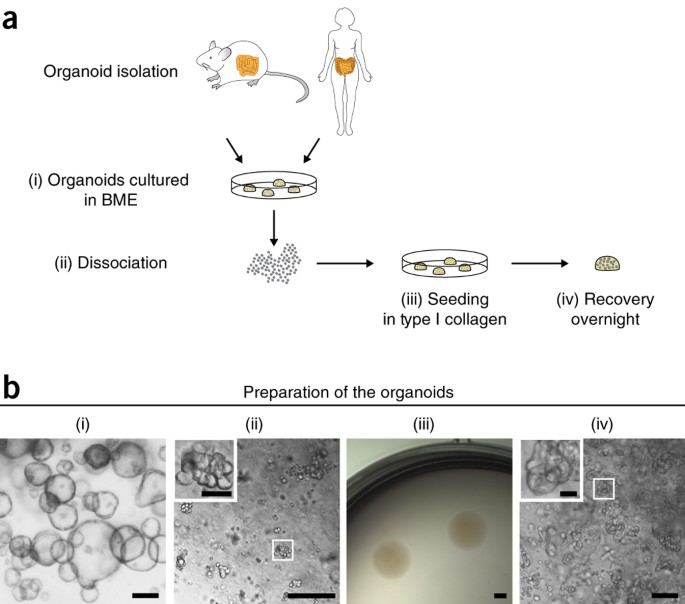
- Select a language for the TTS:
- UK English Female
- UK English Male
- US English Female
- US English Male
- Australian Female
- Australian Male
- Language selected: (auto detect) - EN
Play all audios:
ABSTRACT Most currently available colorectal cancer (CRC) mouse models are not suitable for studying progression toward the metastatic stage. Recently, establishment of tumor organoid lines,
either from murine CRC models or patients, and the possibility of engineering them with genome-editing technologies, have provided a large collection of tumor material faithfully
recapitulating phenotypic and genetic heterogeneity of native tumors. To study tumor progression in the natural _in vivo_ environment, we developed an orthotopic approach based on
transplantation of CRC organoids into the cecal epithelium. The 20-min procedure is described in detail here and enables growth of transplanted organoids into a single tumor mass within the
intestinal tract. Due to long latency, tumor cells are capable of spreading through the blood circulation and forming metastases at distant sites. This method is designed to generate tumors
suitable for studying CRC progression, thereby providing the opportunity to visualize tumor cell dynamics _in vivo_ in real time by intravital microscopy. Access through your institution Buy
or subscribe This is a preview of subscription content, access via your institution ACCESS OPTIONS Access through your institution Access Nature and 54 other Nature Portfolio journals Get
Nature+, our best-value online-access subscription $32.99 / 30 days cancel any time Learn more Subscribe to this journal Receive 12 print issues and online access $259.00 per year only
$21.58 per issue Learn more Buy this article * Purchase on SpringerLink * Instant access to full article PDF Buy now Prices may be subject to local taxes which are calculated during checkout
ADDITIONAL ACCESS OPTIONS: * Log in * Learn about institutional subscriptions * Read our FAQs * Contact customer support SIMILAR CONTENT BEING VIEWED BY OTHERS INDUCIBLE MOUSE MODELS OF
COLON CANCER FOR THE ANALYSIS OF SPORADIC AND INFLAMMATION-DRIVEN TUMOR PROGRESSION AND LYMPH NODE METASTASIS Article 14 December 2020 GASTROINTESTINAL CANCER ORGANOIDS—APPLICATIONS IN BASIC
AND TRANSLATIONAL CANCER RESEARCH Article Open access 18 October 2021 _SLEEPING BEAUTY_ TRANSPOSON MUTAGENESIS IN MOUSE INTESTINAL ORGANOIDS IDENTIFIES GENES INVOLVED IN TUMOR PROGRESSION
AND METASTASIS Article 04 January 2024 REFERENCES * Zauber, A.G. et al. Colonoscopic polypectomy and long-term prevention of colorectal-cancer deaths. _N. Engl. J. Med._ 366, 687–696 (2012).
Article CAS PubMed PubMed Central Google Scholar * Torre, L.A. et al. Global cancer statistics, 2012. _CA Cancer J. Clin._ 65, 87–108 (2015). Article PubMed Google Scholar *
Corbett, T.H., Griswold, D.P. Jr., Roberts, B.J., Peckham, J.C. & Schabel, F.M. Jr. Tumor induction relationships in development of transplantable cancers of the colon in mice for
chemotherapy assays, with a note on carcinogen structure. _Cancer Res._ 35, 2434–2439 (1975). CAS PubMed Google Scholar * Moser, A.R., Pitot, H.C. & Dove, W.F. A dominant mutation
that predisposes to multiple intestinal neoplasia in the mouse. _Science_ 247, 322–324 (1990). Article CAS PubMed Google Scholar * Deming, D.A. et al. PIK3CA and APC mutations are
synergistic in the development of intestinal cancers. _Oncogene_ 33, 2245–2254 (2014). Article CAS PubMed Google Scholar * Hinoi, T. et al. Mouse model of colonic adenoma-carcinoma
progression based on somatic Apc inactivation. _Cancer Res._ 67, 9721–9730 (2007). Article CAS PubMed Google Scholar * Martin, E.S. et al. Development of a colon cancer GEMM-derived
orthotopic transplant model for drug discovery and validation. _Clin. Cancer Res._ 19, 2929–2940 (2013). Article CAS PubMed PubMed Central Google Scholar * In, J.G. et al. Human
mini-guts: new insights into intestinal physiology and host-pathogen interactions. _Nat. Rev. Gastroenterol. Hepatol._ 13, 633–642 (2016). Article CAS PubMed PubMed Central Google
Scholar * Roper, J. et al. _In vivo_ genome editing and organoid transplantation models of colorectal cancer and metastasis. _Nat. Biotechnol._ 35, 569–576 (2017). Article CAS PubMed
PubMed Central Google Scholar * Qin, L., Liu, Y., Wang, J., Li, S. & Sato, Y. Neural and behavioral discrimination of sound duration by cats. _J. Neurosci._ 29, 15650–15659 (2009).
Article CAS PubMed PubMed Central Google Scholar * Sato, T. et al. Long-term expansion of epithelial organoids from human colon, adenoma, adenocarcinoma, and Barrett's epithelium.
_Gastroenterology_ 141, 1762–1772 (2011). Article CAS PubMed Google Scholar * Blokzijl, F. et al. Tissue-specific mutation accumulation in human adult stem cells during life. _Nature_
538, 260–264 (2016). Article CAS PubMed PubMed Central Google Scholar * Koo, B.K. et al. Controlled gene expression in primary Lgr5 organoid cultures. _Nat. Methods_ 9, 81–83 (2012).
Article CAS Google Scholar * van de Wetering, M. et al. Prospective derivation of a living organoid biobank of colorectal cancer patients. _Cell_ 161, 933–945 (2015). Article CAS PubMed
PubMed Central Google Scholar * Fujii, M. et al. A colorectal tumor organoid library demonstrates progressive loss of niche factor requirements during tumorigenesis. _Cell Stem Cell_ 18,
827–838 (2016). Article CAS PubMed Google Scholar * Calon, A. et al. Dependency of colorectal cancer on a TGF-β-driven program in stromal cells for metastasis initiation. _Cancer Cell_
22, 571–584 (2012). Article CAS PubMed PubMed Central Google Scholar * Zomer, A. et al. _In vivo_ imaging reveals extracellular vesicle-mediated phenocopying of metastatic behavior.
_Cell_ 161, 1046–1057 (2015). Article CAS PubMed PubMed Central Google Scholar * Schwitalla, S. et al. Intestinal tumorigenesis initiated by dedifferentiation and acquisition of
stem-cell-like properties. _Cell_ 152, 25–38 (2013). Article CAS PubMed Google Scholar * Fumagalli, A. et al. Genetic dissection of colorectal cancer progression by orthotopic
transplantation of engineered cancer organoids. _Proc. Natl. Acad. Sci. USA_ 114, E2357–E2364 (2017). Article CAS PubMed PubMed Central Google Scholar * Li, X. et al. Oncogenic
transformation of diverse gastrointestinal tissues in primary organoid culture. _Nat. Med._ 20, 769–777 (2014). Article CAS PubMed PubMed Central Google Scholar * Drost, J. et al.
Sequential cancer mutations in cultured human intestinal stem cells. _Nature_ 521, 43–47 (2015). Article CAS PubMed Google Scholar * Matano, M. et al. Modeling colorectal cancer using
CRISPR-Cas9-mediated engineering of human intestinal organoids. _Nat. Med._ 21, 256–262 (2015). Article CAS PubMed Google Scholar * Ritsma, L. et al. Surgical implantation of an
abdominal imaging window for intravital microscopy. _Nat. Protoc._ 8, 583–594 (2013). Article CAS PubMed Google Scholar * Beerling, E. et al. Plasticity between epithelial and
mesenchymal states unlinks EMT from metastasis-enhancing stem cell capacity. _Cell Rep._ 14, 2281–2288 (2016). Article CAS PubMed PubMed Central Google Scholar * Hung, K.E. et al.
Development of a mouse model for sporadic and metastatic colon tumors and its use in assessing drug treatment. _Proc. Natl. Acad. Sci. USA_ 107, 1565–1570 (2010). Article CAS PubMed
PubMed Central Google Scholar * Shibata, H. et al. Rapid colorectal adenoma formation initiated by conditional targeting of the Apc gene. _Science_ 278, 120–123 (1997). Article CAS
PubMed Google Scholar * Zechmann, C.M. et al. Impact of stroma on the growth, microcirculation, and metabolism of experimental prostate tumors. _Neoplasia_ 9, 57–67 (2007). Article CAS
PubMed PubMed Central Google Scholar * Fidler, I.J. Orthotopic implantation of human colon carcinomas into nude mice provides a valuable model for the biology and therapy of metastasis.
_Cancer Metast. Rev._ 10, 229–243 (1991). Article CAS Google Scholar * Cespedes, M.V. et al. Orthotopic microinjection of human colon cancer cells in nude mice induces tumor foci in all
clinically relevant metastatic sites. _Am. J. Pathol._ 170, 1077–1085 (2007). Article CAS PubMed PubMed Central Google Scholar * Melo, F.S. et al. A distinct role for Lgr5+ stem cells
in primary and metastatic colon cancer. _Nature_ 543, 676–680 (2017). Article CAS Google Scholar * Enquist, I.B. et al. Lymph node-independent liver metastasis in a model of metastatic
colorectal cancer. _Nat. Commun._ 5, 3530 (2014). Article PubMed CAS Google Scholar * Yui, S. et al. Functional engraftment of colon epithelium expanded _in vitro_ from a single adult
Lgr5+ stem cell. _Nat. Med._ 18, 618–623 (2012). Article CAS PubMed Google Scholar * O'Rourke, K.P. et al. Transplantation of engineered organoids enables rapid generation of
metastatic mouse models of colorectal cancer. _Nat. Biotechnol._ 35, 577–582 (2017). Article CAS PubMed PubMed Central Google Scholar * Chassaing, B., Aitken, J.D., Malleshappa, M.
& Vijay-Kumar, M. Dextran sulfate sodium (DSS)-induced colitis in mice. _Curr. Protoc. Immunol._ 104, Unit 15.25 (2014). Article PubMed Central Google Scholar * Zigmond, E. et al.
Utilization of murine colonoscopy for orthotopic implantation of colorectal cancer. _PLoS One_ 6, e28858 (2011). Article CAS PubMed PubMed Central Google Scholar * Roper, J. et al.
Colonoscopy-based colorectal cancer modeling in mice with CRISPR-Cas9 genome editing and organoid transplantation. _Nat. Protoc._ (2017). * Byrne, A.T. et al. Interrogating open issues in
cancer precision medicine with patient-derived xenografts. _Nat. Rev. Cancer_ 17, 254–268 (2017). Article CAS PubMed Google Scholar * Broutier, L. et al. Culture and establishment of
self-renewing human and mouse adult liver and pancreas 3D organoids and their genetic manipulation. _Nat. Protoc._ 11, 1724–1743 (2016). Article CAS PubMed Google Scholar * Drost, J.,
Artegiani, B. & Clevers, H. The generation of organoids for studying Wnt signaling. _Methods Mol. Biol._ 1481, 141–159 (2016). Article CAS PubMed Google Scholar * Koo, B.K. et al.
Controlled gene expression in primary Lgr5 organoid cultures. _Nat. Methods_ 9, 81–83 (2011). Article PubMed CAS Google Scholar * Fujii, M., Matano, M., Nanki, K. & Sato, T.
Efficient genetic engineering of human intestinal organoids using electroporation. _Nat. Protoc._ 10, 1474–1485 (2015). Article CAS PubMed Google Scholar * Fu, X.Y., Besterman, J.M.,
Monosov, A. & Hoffman, R.M. Models of human metastatic colon cancer in nude mice orthotopically constructed by using histologically intact patient specimens. _Proc. Natl. Acad. Sci. USA_
88, 9345–9349 (1991). Article CAS PubMed PubMed Central Google Scholar * Klaver, Y.L., Lemmens, V.E., Nienhuijs, S.W., Luyer, M.D. & de Hingh, I.H. Peritoneal carcinomatosis of
colorectal origin: incidence, prognosis and treatment options. _World J. Gastroenterol._ 18, 5489–5494 (2012). Article CAS PubMed PubMed Central Google Scholar * Drost, J. et al.
Organoid culture systems for prostate epithelial and cancer tissue. _Nat. Protoc._ 11, 347–358 (2016). Article CAS PubMed PubMed Central Google Scholar * Chudakov, D.M., Lukyanov, S.
& Lukyanov, K.A. Using photoactivatable fluorescent protein Dendra2 to track protein movement. _Biotechniques_ 42 553, 555, 557 passim (2007). Download references ACKNOWLEDGEMENTS We
thank A. de Graaff and the Hubrecht Imaging Centre for imaging support. We thank O. Sansom and E. Hong Tan (Beatson Institute, Glasgow, UK) for providing the murine tumor organoid line. This
work was financially supported by a Dutch Cancer Society Fellowship (BUIT-2013-5847 to S.J.E.S.), by the Dutch Cancer Society (KWF)/Alpe d′HuZes Bas Mulder Award (KWF/Alpe d′HuZes 10218, to
J.D.), by European Research Council Grant CANCER-RECURRENCE 648804 (to J.v.R.), by the CancerGenomics.nl (Netherlands Organisation for Scientific Research) program (to J.v.R.), by the
Doctor Josef Steiner Foundation (to J.v.R) and by the European Union′s Horizon 2020 research and innovation program under Marie Sklodowska-Curie grant agreement no. 642866 (to J.v.R). AUTHOR
INFORMATION AUTHORS AND AFFILIATIONS * Hubrecht Institute, Royal Netherlands Academy of Arts and Sciences (KNAW) and UMC Utrecht, Utrecht, The Netherlands Arianna Fumagalli, Saskia J E
Suijkerbuijk, Harry Begthel, Evelyne Beerling & Jacco van Rheenen * Molecular Pathology, Oncode Institute, The Netherlands Cancer Institute, Amsterdam, The Netherlands, Utrecht, The
Netherlands Arianna Fumagalli, Saskia J E Suijkerbuijk, Evelyne Beerling & Jacco van Rheenen * Molecular Cancer Research, Center for Molecular Medicine, University Medical Center
Utrecht, Utrecht, The Netherlands Koen C Oost & Hugo J Snippert * Princess Máxima Center for Pediatric Oncology, Utrecht, The Netherlands Jarno Drost Authors * Arianna Fumagalli View
author publications You can also search for this author inPubMed Google Scholar * Saskia J E Suijkerbuijk View author publications You can also search for this author inPubMed Google Scholar
* Harry Begthel View author publications You can also search for this author inPubMed Google Scholar * Evelyne Beerling View author publications You can also search for this author inPubMed
Google Scholar * Koen C Oost View author publications You can also search for this author inPubMed Google Scholar * Hugo J Snippert View author publications You can also search for this
author inPubMed Google Scholar * Jacco van Rheenen View author publications You can also search for this author inPubMed Google Scholar * Jarno Drost View author publications You can also
search for this author inPubMed Google Scholar CONTRIBUTIONS A.F. developed the orthotopic transplantation technique; A.F. and J.D. performed the experiments; H.B., E.B. and S.J.E.S. helped
with data analysis and preparation of the figures; S.J.E.S edited the video; K.C.O. and H.J.S. provided the patient-derived CRC organoids; J.D. and J.v.R. supervised the study; A.F., J.D.
and J.v.R. wrote the manuscript. CORRESPONDING AUTHORS Correspondence to Jacco van Rheenen or Jarno Drost. ETHICS DECLARATIONS COMPETING INTERESTS The authors declare no competing financial
interests. SUPPLEMENTARY INFORMATION 41596_2018_BFNPROT2017137_MOESM136_ESM.MP4 Set up and demonstration of the surgical procedure to transplant CRC organoids into the caecal wall of
recipient mice. (MP4 19876 kb) RIGHTS AND PERMISSIONS Reprints and permissions ABOUT THIS ARTICLE CITE THIS ARTICLE Fumagalli, A., Suijkerbuijk, S., Begthel, H. _et al._ A surgical
orthotopic organoid transplantation approach in mice to visualize and study colorectal cancer progression. _Nat Protoc_ 13, 235–247 (2018). https://doi.org/10.1038/nprot.2017.137 Download
citation * Published: 04 January 2018 * Issue Date: February 2018 * DOI: https://doi.org/10.1038/nprot.2017.137 SHARE THIS ARTICLE Anyone you share the following link with will be able to
read this content: Get shareable link Sorry, a shareable link is not currently available for this article. Copy to clipboard Provided by the Springer Nature SharedIt content-sharing
initiative







